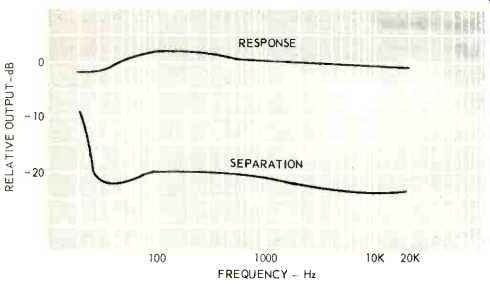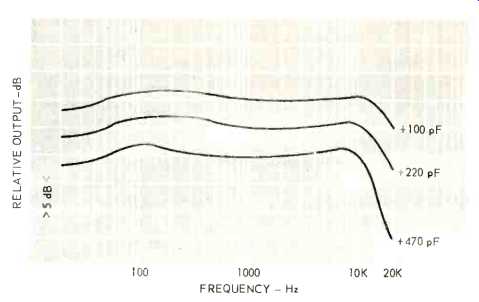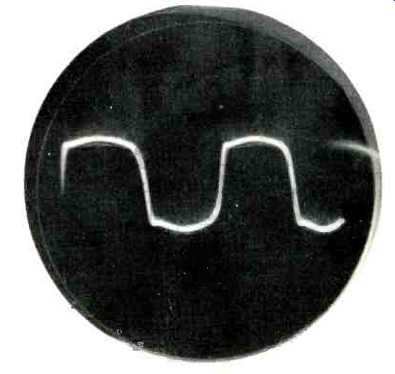
MANUFACTURER'S SPECIFICATIONS
Sensitivity: 3.5 mV at 5.5 cm/sec (nominal).
Suggested Tracking Force: 0.6 grams.
Frequency Response: 10 Hz to 20 kHz ±2 dB.
Channel Separation: 25 dB, 50 Hz to 20 kHz (nominal).
Compliance: 50x10^-6 cm/dyne.
Stylus Tip Dimensions: .0007" x .0003" (elliptical).
Price: $50.00.
The new XLM stereo cartridge by Audio Dynamics differs considerably in construction from the design introduced with the ADC-25, principally in the stylus assembly. In the earlier model, the stylus was installed in a small plastic molding … fitted onto the body of the cartridge, with the … embedded in the cartridge body, … the … was transferred to the tiny soft iron collar on the "working" end of the stylus assembly--that is, the end opposite the stylus tip proper. In the XLM, the stylus assembly, which is similar to that of the earlier models in the stylus bar and its tiny soft iron collar, is mounted in a plastic saddle which slips onto the cartridge body, but the magnet itself is in the saddle, and thus closer to the generating element. It would appear that this creates a greater magnetic field, and thus requires a smaller coil to put out the required signal voltage.
For example, the resistance of the 10E-Mk IV coil is 1025 ohms and the inductance is approximately 700 mH, which is just about the same as that in most other stereo cartridges.
However, the XLM coil has a resistance of only 560 ohms and a much lower inductance of 260 mH. As everybody knows, presumably, the noise output from a transistor amplifier is related to the d.c. resistance of its driving source-not the 47,000 ohms into which practically all cartridges "look into," but the actual d.c. resistance of the source. This would seem to indicate that the XLM could be instrumental in lowering the input noise from the first stage of a modern transistor amplifier.

Fig. 1--Frequency response and separation curves for the XLM cartridge.
A B&K QR-2009 record was used for the 20-20,000 Hz sweep and output was
recorded on a graphic recorder with low-end equalization only.
Aside from that, the XLM has an extremely light stylus support--we used to call the member on which the stylus was mounted the "bar" but this seems inappropriate when the support is a thin hollow tube-and this tiny thin tube is "pivoted" in a flexible diaphragm just slightly off center so that the moment of inertia is minimized. In fact the mass of the stylus and the supporting section of the tube closely approximates the mass of the thin iron collar and its portion of the supporting tube. It is the iron collar which relays the magnetic field through the four pole pieces to produce the signal. And since the magnet itself is not mounted on the stylus support, the mass can be kept at a minimum. The "induced magnet" principle has been used by ADC since its introduction in the Model 25-itself an excellent cartridge.
The usual frequency runs were made with the B & K QR2009 sweep record, and the output-after low-frequency equalization-was recorded, with the result shown in Fig. 1, along with the separation over the frequency range from 20 to 20,000 Hz. Note that response is within -/+2 dB over the entire range, and that separation is better than 20 dB in the midrange and increases in the high end, rather than decreasing as with most cartridges we have measured.
[...] connecting cable between turntable and recorder has a … of 200 pF, possible slightly lower than … installations. To determine the effect of increased lead capacitance, additional runs were made with additional capacitances of 100, 220, and 470 pF added, and the results are also shown in Fig. 2. The increased value of 470 pF introduces a 2-dB peak at 7000 Hz followed by a drop-off to-12 dB at 20,000 Hz. An added value of 220 pF introduced a 2-dB peak at 8500 Hz and a rolloff to-8 dB at 20,000, while an extra 100 pF gave rise of 1 dB at 10,000 Hz with response down 5 dB at 20,000. So it really doesn't matter very much what capacitance your connecting cables have, because the slight rise-referred to above as a 2-dB "peak"-is not particularly noticeable, and with most equipment a droop of 8 dB, or even 12 dB, at 20,000 Hz is only of academic importance. We all like to have perfectly flat response from d.c. to Channel 4, as the saying goes, but then we dump the signal into a loudspeaker which is radiating in a room which may have heavy drapes and lots of overstuffed furniture, or there may be little furniture, no drapes, and no carpet. Let us say, therefore, that the XLM is capable of reproducing practically anything found on a phonograph record.

Fig. 2--The effects of 100 pF, 220 pF, and 470 pF capacitances on the response
curve. Connecting cable has a capacitance of 200 µF.

Fig. 3--Square-wave response from the XLM cartridge, using a CBS STR-111
test record with a flat preamplifier.
If you have read any of the company's advertising about the XLM, you are aware that the "LM" stands for low mass, and that there is also a VLM cartridge for use on turntables requiring a stylus force greater than one gram. The difference between the XLM and the VLM is solely in the stylus assembly--the bodies are identical. This means that you can buy the VLM for use with your present not-so-perfect turntable, and when you upgrade it next year, you can also upgrade the cartridge to the XLM by getting the "X" assembly and slipping it onto your present cartridge body. Not such a bad idea, since the body is guaranteed for ten years. The VLM lists at $40.00, so the difference you save now could well apply on the cost of the "X" stylus assembly when you upgrade the system.
It will be noticed from the response curve that there is practically no resonance peak in the upper range-in many it appears around 19 kHz. This is the result of the exceptionally low mass and the built-in electro-dynamic damping of the induced magnet system.
Measured output from the two channels from the 3.54 cm/ sec band of 1000 Hz was 4.0 and 3.7 mV respectively, using the CBS BTR-150 broadcast test record-less than 1 dB difference. Those who have followed IM distortion measurements in these pages with respect to cartridges will recall that we report on the +9-dB band of lateral 200/4000 Hz, and the +6-dB band of vertical 200/400. (The CBS-STR-111 record has five levels of 400/4000, five levels of 200/4000, in the lateral mode, and three levels each of vertical 400/4000 and 200/4000-far too many to report on in every profile.) Lateral IM distortion measured 1.5% on the chosen band, and 3.0% in the vertical mode. These compare with 1.5% and 4.4% respectively for the ADC 25. This amount of lateral IM distortion is about par for stereo cartridges, but the vertical IM in most models ranged from 4.5% to 10%, so the XLM has remarkably low distortion in comparison with others.
Listening Tests
Tracking tests were made using the CBS STR-100 record, and viewing the output on a scope indicated that the XLM could track every band except the highest level at the recommended stylus force of 0.6 grams, and the highest band with a stylus force of 0.8 grams with no visible mistracking. Then, using a flat preamp and the ubiquitous scope, we looked at the square-wave output, as shown in Fig. 3. Only then did we listen to the cartridge to find that it sounds as good as it measures. Smooth, clean, and with no apparent peaks; good solid bass, and a minimum of noise.
We tried it on every possible type of music in our library and found complete satisfaction with its performance. Reducing stylus force to 0.4 grams made no appreciable difference in the quality of sound, but did show up an occasional mistracking on the very lowest notes. At the recommended 0.6 grams, however, none of this was noticed. On the whole, the XLM appears to be "state of the art," and priced as it is, it is a real bargain in cartridges.
-C. G. McProud
(Audio magazine, Jul. 1972)
Also see:
ADC Stereo Cartridge 10E MK IV (Equip. Profile, Dec. 1972)
ADC Model LMF-2 Tonearm & ZLM Phono Cartridge (Equip. Profile, Jan. 1979)
ADCOM Crosscoil XC/VAN DEN HUL Moving-Coil Phono Cartridge (Jan. 1982)
Decca London International Tonearm & Mk VI Gold Elliptical Phono Cartridge (Aug. 1979)
= = = =